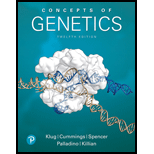
Concept explainers
Canine hip dysplasia is a quantitative trait that continues to affect most large breeds of dogs in spite of approximately 40 years of effort to reduce the impact of this condition. Breeders and veterinarians rely on radiographic and universal registries to facilitate the development of breeding schemes for reducing its incidence. Data [Wood and Lakhani (2003). Vet. Rec. 152:69–72] indicate that there is a “month-of-birth” effect on hip dysplasia in Labrador retrievers and Gordon setters, whereby the frequency and extent of expression of this disorder vary depending on the time of year dogs are born. Speculate on how breeders attempt to “select” out this disorder and what the month-of-birth phenomenon indicates about the expression of polygenic traits.
Want to see the full answer?
Check out a sample textbook solution
Chapter 25 Solutions
Concepts of Genetics (12th Edition)
- Clubfoot and spina bifida are traits best explained by the Threshold Model of complex traits. The Threshold Model explains the distribution of some complex traits. Only those individuals who have a genetic liability above a certain threshold are affected if exposed to certain environmental factors, such as continuous; maternal age continuous; maternal nutrition discontinuous; maternal nutrition discontinuous; maternal intelligence none of these are correctarrow_forwardWhat are some of the key differences and applications of genetictesting for prognostic versus diagnostic purposes?arrow_forwardA prospective groom, who is normal, has a sister with cystic fibrosis (CF), an autosomal recessive disease. Their parents are normal. The brother plans to marry a woman who has no history of CF in her family. What is the probability that they will produce a CF child? They are both Caucasian, and the overall frequency of CF in the Caucasian population is 1/2500—that is, 1 affected child per 2500. (Assume the population meets the Hardy–Weinberg assumptions.)arrow_forward
- Briefly describe the polygenic threshold theory. How polygenic traits can be genetically determined? What are major factors affecting gene frequencies? How the Hardy-Weinberg relationship can be used in genetic counseling? Is it useful for genetic risk prediction?arrow_forwardSix single-nucleotide polymorphism (SNP) loci are known to contribute to the development of type 2 diabetes. Diabetes is certain if eight or more of the alleles at these six loci are of the “contributing” variety. An uppercase letter indicates an allele that contributes to diabetes and a lowercase symbol indicates a noncontributing allele. A married couple wants to know the probability of producing a child who is at severe risk of type 2 diabetes. Their genotypes were determined by microarray analysis and are as follows: AaBbccDDEEFf × AaBbCCDdEeFfarrow_forwardThe most common CF mutation is AF508; it accounts for approximately 70% of all mutant CFTR alleles worldwide. For a couple of northern European origin, what is their risk for having an affected child if each tests negative for AF508? If one tests positive and the other tests negative for AF508?arrow_forward
- What is a ”profile probability,” and what information is required in order to calculate it?arrow_forwardWhat are newest advances in early diagnosis and confirmation of Huntington disease? Explain the difference in inheritance pattern and the frequency to have affected progeny in the case of these three inherited diseases: Huntington, Cystic fibrosis and Duchenne muscular dystrophy. What therapies can be used or recommended for patients experiencing any of these inherited diseases?arrow_forwardWhich of these is not true of single nucleotide polymorphisms (SNPs)? are single base-pair variations in the genomes of the human population are genetic markers used to study the genetic basis for disease vary from 1-3 bases in length are the most common type of genetic variancearrow_forward
- Answer in less than 30 words:Why are mathematical /statistical tools needed in the understanding of the transmission of traits in the field of Genetics?arrow_forwardWhat is the aid to determining whether observed results should be viewed as common or rare outcomes?arrow_forwardWhat is the frequency of the aa genotype if the frequencies of AA and aa are 0.19 and 0.36?arrow_forward
 Concepts of BiologyBiologyISBN:9781938168116Author:Samantha Fowler, Rebecca Roush, James WisePublisher:OpenStax College
Concepts of BiologyBiologyISBN:9781938168116Author:Samantha Fowler, Rebecca Roush, James WisePublisher:OpenStax College Human Heredity: Principles and Issues (MindTap Co...BiologyISBN:9781305251052Author:Michael CummingsPublisher:Cengage Learning
Human Heredity: Principles and Issues (MindTap Co...BiologyISBN:9781305251052Author:Michael CummingsPublisher:Cengage Learning

